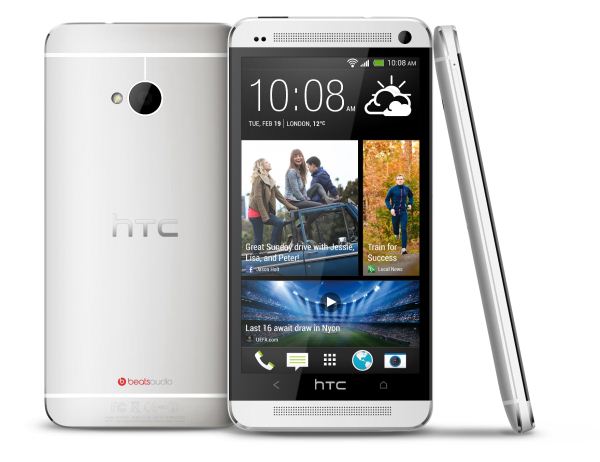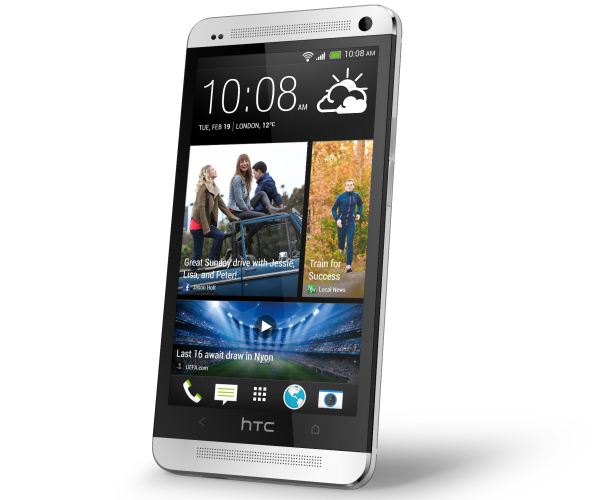Hands on and Impressions from the HTC One - Formerly M7
by Brian Klug on February 19, 2013 10:30 AM EST- Posted in
- Smartphones
- HTC
- Mobile
- HTC One
- Snapdragon 600
HTC is in an interesting position as a result of this last product cycle. While the previous HTC One series’ industrial design and performance was top notch, other OEMs still managed to eclipse the One series in terms of market adoption and consumer perception. Getting back to being a solid performer and cementing a place as at least the dominant number three player in the smartphone space is HTC’s mission for 2013, and the flagship device it’s starting that out with is the device previously known as M7, now known simply as the HTC One.
Design and Construction
The choice of the HTC One name really emphasizes how much this launch means to HTC — this is the canonical One. This is the fullest expression of HTC’s view for what the One lineup should mean, this is their flagship. The One is a clear evolution of the industrial design first begun with the Butterfly and DNA, except instead of plastic the One is machined from a single solid block of aluminum. There are over 200 minutes of CNC machine cuts per device, which is a unibody construction. Plastic is injected into the aluminum block after certain cuts are made for the back case, which then gets machined into the final form. The One uses the top and bottom aluminum strips for antennas, both of which are actively tuned to mitigate unintended attenuation from being held. There’s a plastic insulative strip in-between the two antennas and the main body. In spite of being aluminum, the One also includes NFC, whose active area surrounds the camera region. There’s no wireless charging from Qi or WPC, however.
In the hands the HTC One has the kind of fit and finish that I’d expect from a high end device. I thought that the One S was perhaps the best industrial design of 2012 in part thanks to the metal backside, unique concave shape, and size. The truth is that the HTC One feels even better than that. There’s something inescapable about metal — HTC described it as expensive and luxurious feeling, like a well crafted tool. Other OEMs with metal phones like to evoke imagery of watches or high end jewelry. I think at some fundamental level metal does imply value, and as a result it conveys a much higher end in-hand feel than other entirely polycarbonate plastic designs. There’s a thin strip of plastic which runs around the edge of the device, and it’s here that the microSIM tray, ejection port, primary microphone, microUSB port, power/lock button (which doubles as IR transmit and receive), earphone jack, and volume rocker sit. The front has two aluminum pieces which serve as the speaker, microphone, and earpiece grilles. The HTC One will come in both an uncolored silver version, and anodized black.
The One is topped with a 4.7-inch 1080p Super LCD 3 display. We’ve said that 2013 is going to be the year of 5-inch phones, and 4.7 is just shy. I think there’s something almost optimal about the device size that results with a 16:9 display size just short of 5-inches diagonal. It’s still possible to one hand if you have medium sized hands, easy to pocket, and still not laughably huge.
The HTC One at first glance might seem reminescent of another big metal unibody device, but in the hand couldn’t feel any more different. The convex rounded back side gives the One an entirely different in-hand feel, and the edges have a slight negative angle to them in addition to two chamfers.
Rather than place the primary speaker on the backside of the One, HTC has placed a set of speakers on the front of the device, one at top, one at bottom, behind the two grilles. These two provide stereo sound, and placing them on the front instead of the bottom or back makes a lot of sense for things like watching video, Google Navigation, and listening to music. The One also has dual microphones for noise rejection on calls, and also two different microphone pairs for accommodating low volume and high volume environments when recording audio. For example the commodity microphones generally included in a smartphone saturate around 70 dBA, HTC claims the dual microphone system on the One can accommodate up to 120 dBA SPL (Sound Pressure Level) without saturating.


















139 Comments
View All Comments
aegisofrime - Tuesday, February 19, 2013 - link
Believe it or not, the HTC One looks strikingly similar to a Chinese phone that was released a few months ago. Take a look:http://i.imgur.com/IX3Qqsi.jpg
Silenus - Tuesday, February 19, 2013 - link
For me it is tremendously refreshing to finally see someone other than Nokia focusing heavily on camera quality and features...and NOT on megapixels. Larger pixels, F/2, and optical stabilization is what I've been waiting for in an Android phone!amdwilliam1985 - Tuesday, February 19, 2013 - link
Yep, waiting for a test of HTC One against Lumia 920.BoloMKXXVIII - Tuesday, February 19, 2013 - link
As someone who does not use social media, Blinkfeed is useless. Yes, you can move it off the main page, but you cannot turn it off. All those updates to the tiles keep burning battery. As for the battery, it needs to be larger. Phones do not need to be so thin you can shave with them. The DO need to last all day (with all day use). While local storage is very good, I still want the microSD card slot. Transferring large files/large numbers of tiles/viewing photos from my REAL camera is just easier with microSD. All aluminum body is dead sexy, but aluminum is a fairly soft metal and will scratch easily. Must have a case. FINALLY someone (other than Nokia) is doing something about the cameras on cell phones. Low light sensitivity always suck on cell phones. Glad to see this one being addressed. 4 MP is plenty for a phone. Want a picture you can blow up to life size? Use a DSLR. Most people are not talking about the addition of IR. This is big for me! With IR, Bluetooth and Wifi I can control everything in my house! Finally, can the phone be purchased unlocked? If so, how much? I don't think this is "the" phone for me but I hope HTC uses some of these features in future phones (a max battery version would be nice).tomeklutel - Tuesday, February 19, 2013 - link
No AMOLED, larger and heavier than S2, this phone sucks.bernstein - Tuesday, February 19, 2013 - link
who the fuck wants amoled? everyone i know who owns a galaxy says the're great except for screen brightness.... go figure.Sm0kes - Tuesday, February 19, 2013 - link
It's made of metal..... so.... umm.... weight wise, that's not really a surprise.Also, the display has yet to be tested. simply stating that it isn't AMOLED is meaningless. I'll reserve judgement until we see test results and more details.
bernstein - Tuesday, February 19, 2013 - link
@anand i really wonder if a 13MP sensor of the same size (amounts to ~1µm per pixel) and using 4 sensor pixels per image pixels in low light wouldn't be the better choice...- great big outdoor pictures
- small but bright indoor pictures...
at least in theory this 4:1 mapping should result in approx. the same performance, or is this impractical???
nerd1 - Tuesday, February 19, 2013 - link
You don't need large pixels for brighter image, you need long exposure.And yes, pixel binning (essentially resizing) will produce almost as good results as larger, fewer pixels. One prime example is Nikon's D800.
pshann - Thursday, February 21, 2013 - link
According to this website (http://lifeinmegapixels.com/blog/2012/01/pixel-bin... Post-process pixel binning doesn't improve the picture quality...